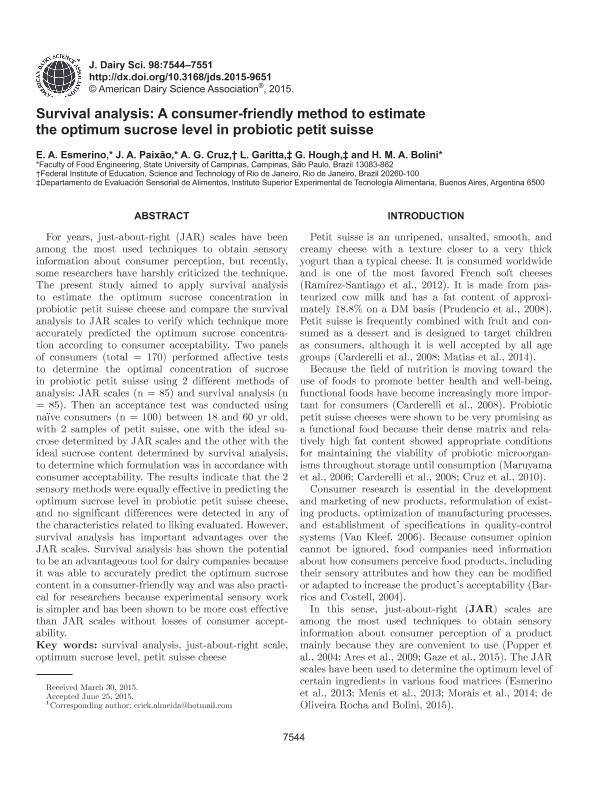Mostrar el registro sencillo del ítem
dc.contributor.author
Esmerino, E. A.
dc.contributor.author
Paixão, J. A.
dc.contributor.author
Cruz, A. G.
dc.contributor.author
Garitta, Lorena Garitta

dc.contributor.author
Hough, Guillermo

dc.contributor.author
Bolini, H. M. A.
dc.date.available
2018-04-17T15:02:06Z
dc.date.issued
2015-11
dc.identifier.citation
Esmerino, E. A.; Paixão, J. A.; Cruz, A. G.; Garitta, Lorena Garitta; Hough, Guillermo; et al.; Survival analysis: A consumer-friendly method to estimate the optimum sucrose level in probiotic petit suisse; American Dairy Science Association; Journal of Dairy Science; 98; 11; 11-2015; 7544-7551
dc.identifier.issn
0022-0302
dc.identifier.uri
http://hdl.handle.net/11336/42252
dc.description.abstract
For years, just-about-right (JAR) scales have been among the most used techniques to obtain sensory information about consumer perception, but recently, some researchers have harshly criticized the technique. The present study aimed to apply survival analysis to estimate the optimum sucrose concentration in probiotic petit suisse cheese and compare the survival analysis to JAR scales to verify which technique more accurately predicted the optimum sucrose concentration according to consumer acceptability. Two panels of consumers (total = 170) performed affective tests to determine the optimal concentration of sucrose in probiotic petit suisse using 2 different methods of analysis: JAR scales (n = 85) and survival analysis (n = 85). Then an acceptance test was conducted using naïve consumers (n = 100) between 18 and 60 yr old, with 2 samples of petit suisse, one with the ideal sucrose determined by JAR scales and the other with the ideal sucrose content determined by survival analysis, to determine which formulation was in accordance with consumer acceptability. The results indicate that the 2 sensory methods were equally effective in predicting the optimum sucrose level in probiotic petit suisse cheese, and no significant differences were detected in any of the characteristics related to liking evaluated. However, survival analysis has important advantages over the JAR scales. Survival analysis has shown the potential to be an advantageous tool for dairy companies because it was able to accurately predict the optimum sucrose content in a consumer-friendly way and was also practical for researchers because experimental sensory work is simpler and has been shown to be more cost effective than JAR scales without losses of consumer acceptability.
dc.format
application/pdf
dc.language.iso
eng
dc.publisher
American Dairy Science Association

dc.rights
info:eu-repo/semantics/openAccess
dc.rights.uri
https://creativecommons.org/licenses/by-nc-nd/2.5/ar/
dc.subject
Survival Analysis
dc.subject
Optimum Sucrose Level
dc.subject
Just-About-Right Scale
dc.subject
Petit Suisse Cheese
dc.subject.classification
Alimentos y Bebidas

dc.subject.classification
Otras Ingenierías y Tecnologías

dc.subject.classification
INGENIERÍAS Y TECNOLOGÍAS

dc.title
Survival analysis: A consumer-friendly method to estimate the optimum sucrose level in probiotic petit suisse
dc.type
info:eu-repo/semantics/article
dc.type
info:ar-repo/semantics/artículo
dc.type
info:eu-repo/semantics/publishedVersion
dc.date.updated
2018-04-17T13:48:47Z
dc.journal.volume
98
dc.journal.number
11
dc.journal.pagination
7544-7551
dc.journal.pais
Estados Unidos

dc.description.fil
Fil: Esmerino, E. A.. Universidade Estadual de Campinas; Brasil
dc.description.fil
Fil: Paixão, J. A.. Universidade Estadual de Campinas; Brasil
dc.description.fil
Fil: Cruz, A. G.. Instituto Federal de Educação, Ciência e Tecnologia do Rio de Janeiro; Brasil
dc.description.fil
Fil: Garitta, Lorena Garitta. Provincia de Buenos Aires. Dirección General de Cultura y Educación. Instituto Superior Experimental de Tecnología Alimentaria. Departamento de Evaluación Sensorial de Alimentos; Argentina. Consejo Nacional de Investigaciones Científicas y Técnicas; Argentina
dc.description.fil
Fil: Hough, Guillermo. Provincia de Buenos Aires. Dirección General de Cultura y Educación. Instituto Superior Experimental de Tecnología Alimentaria. Departamento de Evaluación Sensorial de Alimentos; Argentina. Consejo Nacional de Investigaciones Científicas y Técnicas; Argentina
dc.description.fil
Fil: Bolini, H. M. A.. Universidade Estadual de Campinas; Brasil
dc.journal.title
Journal of Dairy Science

dc.relation.alternativeid
info:eu-repo/semantics/altIdentifier/doi/http://dx.doi.org/10.3168/jds.2015-9651
dc.relation.alternativeid
info:eu-repo/semantics/altIdentifier/url/https://www.sciencedirect.com/science/article/pii/S0022030215006682
Archivos asociados
